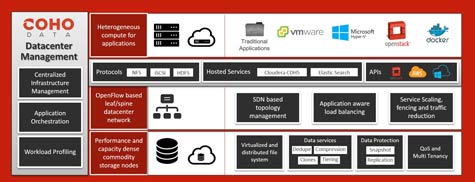One thing that has become apparent over the last year is that, depending on the starting point, there are going to be multiple ways of building a software-defined data center (SDDC). Some organizations will start at the network level and work their way up. Others will find that some form of convergence involving compute and storage will be the best place to start.
Coho Data today announced an update to its namesake software for creating an SDDC that adds support for the Hadoop Distributed File System (HDFS) alongside existing support for file and block storage.
Sanjay Jagad, director of product marketing for Coho Data, says version 2.8 of the company’s namesake software makes it possible to mix and match compute and storage resources to create an SDDC on top of a traditional rack system that includes integration with multiple third-party software-defined networks (SDNs).
The result, says Jagad, is an ability to deploy an SDDC on a private cloud that can not only support any type of workload, including Docker containers that can be orchestrated using the open source Kubernetes container management platform, but also enable IT organizations to control the quality of service any of those workloads receive.
Many IT organizations have been investing in new converged and hyperconverged systems as a first step toward creating an SDDC. Coho Data is making a case for a software approach to creating an SDDC using rack systems consisting of servers and storage systems from multiple hardware vendors. At the core of that debate is how tightly compute and storage resource should be coupled.
“IT organizations can scale out compute and storage independently of one another,” says Jagad. “This is a true scale-out architecture.”
However IT organizations choose to create a SDDC, the need of increased IT agility is putting pressure on IT organizations to master all aspects of software-defined infrastructure (SDI) sooner than later. Otherwise, the balance of application workloads in the next few years will decidedly shift toward public clouds that right now are simpler to manage. That shift may not obviate the need for internal IT organizations altogether, but it sure does have career implications for IT professionals that currently specialize in any part of the IT infrastructure stack itself.



